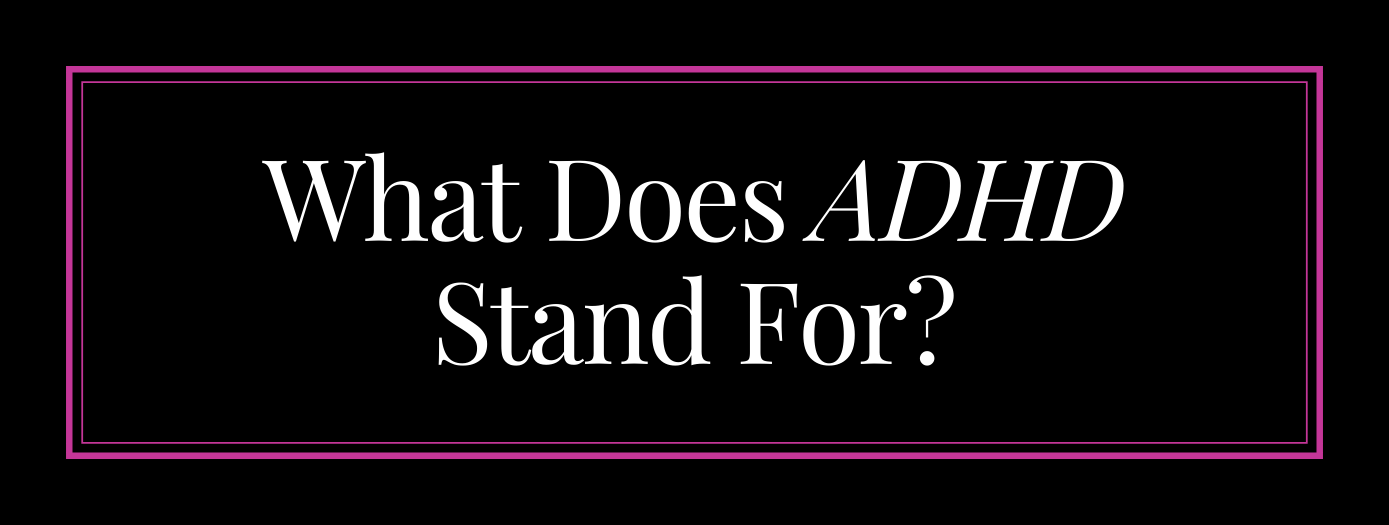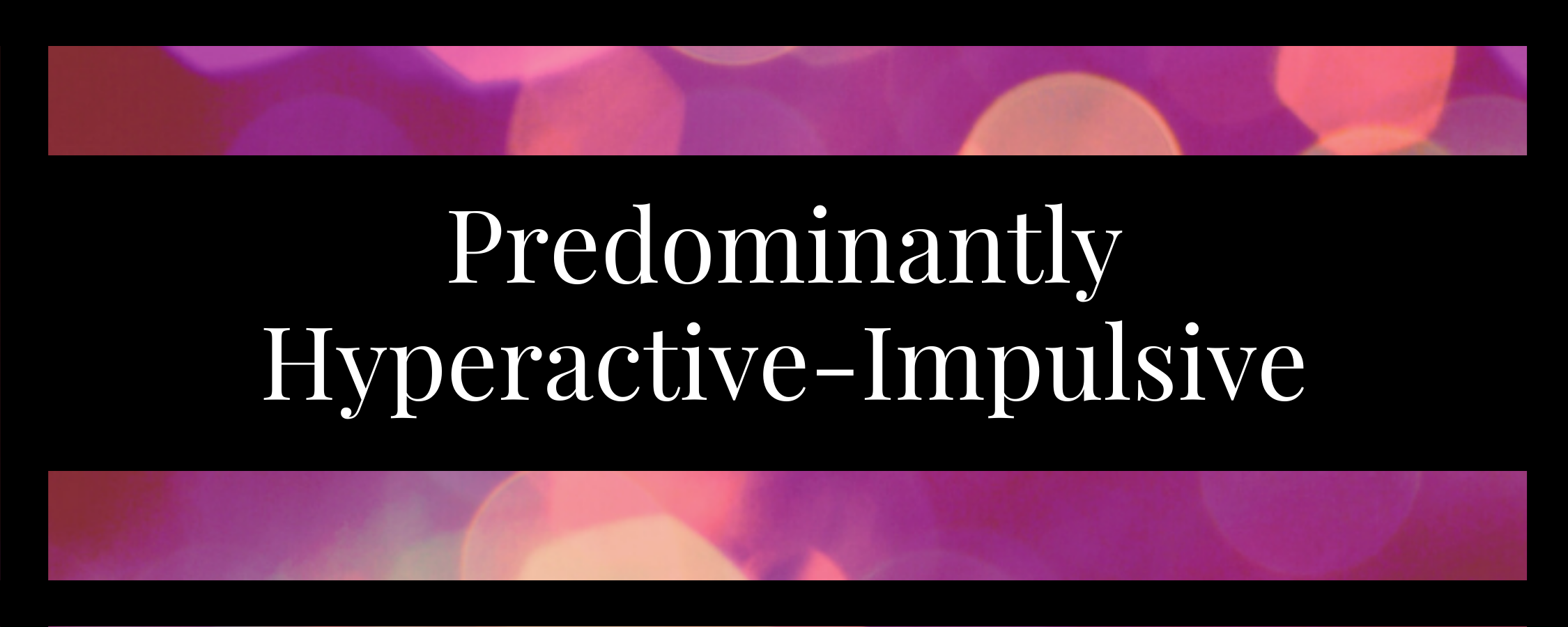
Ooof, this is a tough, multifaceted question to answer.
If you were to stick this question into your search engine (pretending for a minute, that you haven’t done that a million times already) we can guarantee you’ll return an array of incredibly varied answers.
Let’s break it down into chunks…
ADHD Stands for Attention Deficit Hyperactivity Disorder, which we, among many others, have very strong feelings about (not good ones). But we’ll try to give you a succinct overview.
As many of you will probably already be aware of; there is a specific stereotype that springs to mind when most people hear “ADHD”. The vision that is attached to that stereotype, is usually something similar to the 8/9-year-old boy seen running riot around the supermarket, screaming at his parents, pulling stuff off the shelves and hitting his little sister, whilst many bystanders are providing his parents with looks of disapproval and muttering to their partners “That kids needs a good hiding!”.
There was a time - not so long ago - when it was, that that was solely what ADHD was believed to be and while understanding very little about it, the name made sense; it was thought to be a condition that only affected little boys, was always exhibited in this way, and was something they would - in time - grow out of.
Over the last few decades, more and more has come to light, around what ADHD really is, which has debunked most what we once believed. What is now known deems the name false and not at all representative of the condition itself - in fact, mostly, what the name suggests, couldn’t be further from the truth.
It’s a Neurological Condition
ADHD falls under the neurodiversity banner, which in simplified terms means a brain that functions and processes information in a non-typical way.
ADHD isn’t a behavioural condition, nor is it a mental health illness. It’s now understood to be a developmental impairment that affects the regulation of dopamine within the brain - a vital chemical neurotransmitter that is responsible for carrying signals between the different regions of the brain - and can have a significant impact on a person’s cognitive functions, executive functions, and emotional reactions.
There are 3 clinically recognised subtypes of ADHD:
Predominantly hyperactive-impulsive
Predominantly inattentive
Combined
Contrary to common belief, this condition doesn’t have a gender preference and adults do have it too - while it’s long been believed that this is a childhood condition that people grow out of, we now know that this is often not the case.
In fact, there are currently some suggestions floating around about the possibility of - in some cases - ADHD not (identifiably) being present at all until later in life. The main theory around this is based on hormone fluctuations - predominantly oestrogen and progesterone - which impacts the regulation of dopamine within the brain and exacerbates the symptoms of ADHD.
There is so much more we can discuss here, but for now, let’s discuss the 3 main subtypes of ADHD…
This subtype of ADHD is certainly the most ‘well known’ - well, we should say - is the one that people believe they know. This is the stereotype that we’ve already discussed - the image of the little boy running riot in the supermarket.
A person with this subtype would often be quite simple for the trained eye to spot, and common traits that may be exhibited would be;
Struggling to sit still, fidgeting in their seat, leaving their sit, frequently tapping their hands / feet, or fiddling with ‘things’.
Seem to have a constant supply of high energy - running, climbing when (usually exhibited during childhood, which can reduce throughout maturity and become more visibly and obviously restless) in settings where it’s inappropriate.
Could be described as though they are “run by a motor”, constantly on the hunt for new stimulation.
Experiencing random bursts of energy.
They may have the ability to talk ‘until the cows come home’. When discussing a topic of interest, they may become much more excited and animated than most and quite difficult to interrupt.
They may seem like they want to be the centre of attention, constantly making noise (talking for no reason, humming, singing or using a variety of objects as a drum kit!), forever cracking jokes or doing something daft or crazy to provoke reaction.
Struggling to wait for an appropriate opportunity to provide their input during a conversation. They may frequently interrupt others or talk over them.
May seem to lack a filter - speaking before thinking / being brutally honest / using inappropriate language.
Can intrude on others, such as intruding personal space, joining a conversation that they were not invited to, interrupt (and sometimes try to take over) something that another person is doing.
Their emotions may seem disproportionate compared to the situation; they may seem to get very angry, upset or frustrated for little or no reason, and / or seem to be ‘bouncing off the walls’ with excitement, over something that seems quite normal or even mundane to others.
Seemingly reckless and / or fearless - will do something without considering the consequences first, or will take the risk even if the consequences have been considered, eg, creating their very own questionable skate park in their garden out of some loose bricks and a questionable sheet of plywood, driving at 70mph down an unknown country lane, or gambling your entire life’s savings on your hand, during a friendly game of Poker.
Adrenaline junkies - constantly on the lookout for new and increased stimulation, it’s not uncommon for them to have an insatiable desire for extreme (often dangerous) activities.
Although this subtype can often be seen to externalise their symptoms / behaviours which can help to identify ADHD, it is very important to know that these can also be internalised - especially in females - and some individuals may outwardly seem to fit the characteristics of the ‘inattentive subtype’, which you’ll see defined below.
This subtype is much more common in females and is arguably the most worrying as the symptoms they tend to display are much more discreet, which means it’s much trickier to identify.
On top of the symptoms being much more subtle; the symptoms exhibited are very similar to multiple other mental health conditions such as, anxiety, depression, borderline personality disorder (BPD), bipolar disorder (BD), etc, which often leads to a misdiagnosis. And even if the condition/s that has been identified, do exist, they are likely a by-product of ADHD. This means that not only are the odds stacked against their symptoms being identified, but even if the symptoms are identified, they are unlikely - in many cases - to have the root cause itself (their ADHD) identified and treated.
Common traits for this subtype are:
Lack of motivation - can be viewed as lazy or they may seem (rudely) disinterested
Are easily bored and struggle to maintain concentration. It may be misunderstood as them not understanding or caring about the stakes at play in certain situations, no matter how much that point is stressed.
Disorganised and may seem a bit of a “scatter brain” - often losing things, surrounded by clutter and chaos, OR, can be extremely (perhaps obsessively) organised and tidy, which would be caused through fear of losing control, as they are acutely aware of constantly balancing on the precipice that can easily crumble away, tipping them into a chaos, or through fear of exposing themselves as a “failure”.
Prone to making careless at times and seem to pay little attention to detail, or even leave a task completely unfinished
Poor time management - we often use the term “time blind”. No matter how much time they have, they just seem to have a knack of always being late. They often grossly underestimate the time it will take to perform a task, even if it’s a daily routine (if they say they’ll be ready to leave in ten minutes, you can usually expect this to translate to half an hour). They can also be so unaware of how quickly time is passing, that they may genuinely think it’s around 11am, until they receive a call from their child’s school, wondering where they are at 3:45pm!
Forgetful - continually missing appointments, get to the checkout and realise they don’t have their purse or wallet (thank goodness for payment apps - our phones are rarely forgotten!), will (far more frequently than usual) walk into a room to get something and forget what it was, or see something else that reminds them about that other ‘thing’ they forgot to do and end up changing tasks entirely without realising.
Easily distracted or the complete opposite, and be impossible to distract. Although they can have one without the other, usually they will flit between the two extremes and won’t experience anything in the middle. They are either in “the zone” as if no outside world exists, or have such little interest, that anything even slightly more stimulating than the current task will immediately captivate their attention.
Can often seem to not be listening when being directly spoken to - their mind seems to wander very easily.
May often refuse, avoid or be reluctant to engage in mentally draining, lengthy or boring tasks, such as homework, general admin tasks, clearing out / organising spaces, responding to messages (that they know will prompt a response and another message that they need to respond to).
They may come across as introverted, tend to “sit in the background”, avoid bringing any unnecessary attention to themselves and seem to be quite uninterested in social interaction (especially if they are in the company of people they’re not overly familiar with). With this trait, it’s not uncommon for them to demonstrate the polar opposite of this at times, which tends to depend on the environment and the people they’re with.
This is the most common subtype of ADHD and as its name suggests; people with Combined ADHD possess a varied combination of the traits / symptoms from the other two subtypes.
It is very important to be aware that many of the symptoms can be internalised or externalised and they may not be very obvious to spot at all even if they do have symptoms that fall into the hyperactive-impulsive category, which is especially likely to happen in females.

This Quokka has absolutely no relevance whatsoever - It’s cute and you need dopamine.
Just look at that little smiley face - you’re welcome!
Although we are rapidly learning more and more about ADHD; researching and studying this condition is incredibly challenging for multiple reasons. Apart from the issue (we’re guessing they must experience) of people forgetting to show up to the appointments, the main issue is that no two people with ADHD are the same, and therefore, the results are incredibly varied and even contradictory at times.
Another difficulty with studying the ADHD brain, is due to the bulk of diagnosed (potential case studies), being the ‘hyperactive-impulsive’ subtype (the stereotype that everyone thinks of) - hyperactivity is far more obvious than any of the other associated characteristics, so the more hyperactive (seemingly naughty / hard to control) you are / were during childhood, the more likely you are to become diagnosed - of course, only the diagnosed could become case studies for a condition.
Although the ratio of the other subtypes being diagnosed is now increasing, the research on these brains is very much in its infancy and still significantly underrepresented within the diagnosed demographic. So, the truth is, there is a great deal we’ve come to know, but we don’t really know all of what’s going on inside our brains, for certain. We can only take a view on which research seems to match up with the real experiences of those with ADHD.
Superpowers!
Although an often contentious topic (and for good reason too), we do feel strongly about advocating for the positives that are very frequently linked to ADHD…
The above is often stated as a quote made by Albert Einstein, although that doesn’t seem to be true. But - whatever the source - we love it and think it sums it all up beautifully.
Edward Hallowell - one of the world’s most renowned and respected psychiatrists and leaders in the realms of ADHD - is well known for celebrating ADHD and frequently uses the analogy of ADHD brains being like ‘‘Ferrari racing cars, with bicycle brakes’’. This is another favourite of ours, that not only highlights how amazing these brains are, but can also offer an insight into the problems we face and the difficulties that many neurotypical people have in being able to relate and support us.
If the vast majority of our population’s brains are respected, sturdy, reliable ‘Volvos’, then it would make complete sense that most of our ‘mechanics’ would be specialised in fixing and maintaining Volvos. So, you could reasonably expect that when being faced with a Ferrari, a mechanic would likely only be able to apply their Volvo knowledge, strategies and expertise, and use their Volvo tools, or would possibly even try to strip the Ferrari back in order to turn it into as much of a Volvo as is possible. What we need is Ferrari specialists who can either upgrade our brakes or teach us how to best use the brakes we have, without compromising our performance too much.
If you suspect that you may have ADHD, it is essential to seek professional medical advice as soon as possible. The easiest (cheapest) way to do this by speaking to your GP and requesting a referral for an ADHD assessment.
If you’re not sure enough - of ADHD being a possibility - to begin this process, then there are some fantastic resources available, which provide a great deal of reliable information. Here are a few of our recommendations (which we have no affiliation with):
There are many great books, audiobooks and podcasts available on the topic, provided by many ADHD specialists and experts. Here is a list of some of our favourites - there are far too many to list them all:
- Russell A. Barkley
- Sari Solden
- Edward Hallowell
- Thom Hartmann
- Stephanie Sarkis
- William Dodson
- Tracey Otsuka - ADHD for Smart Ass Women
At present there are extremely long waiting lists in most areas of the UK, with some services not being able to offer an assessment for over 4 years. In addition to this, many people have reported to have been met with some resistance from their GPs when requesting a referral, so we strongly recommend that you are well prepared prior to speaking with your GP. Here are a few tips:
Use this self-reporting document - this is a requirement for all NHS referrals in the UK
As the above document is quite vague, it helps a great deal if you’re able to provide real-life examples / stories, as supporting evidence for your symptoms and explain the impact that these have on your life.
Know your rights. People in England have a legal right to choose their mental healthcare provider, which includes a list of alternative providers. ADHD UK have a very helpful and informative page explaining this, and includes a list of providers as well as a downloadable ‘right to choose’ letter that can be provided to your GP.
Try to obtain old school reports and take any with you that provide evidence of possible ADHD symptoms, such as; daydreaming, argumentative, can’t / won’t focus, have ability but won’t apply yourself, lacks interest, etc.
Ask parents / family members if there were any signs of ADHD during childhood - provide them with the specific symptoms that you believe may be relevant, as they may have a completely different understanding of ADHD symptoms.
When contacting your GP’s surgery, ask if there is a particular GP who has a good understanding of ADHD.
Be prepared for the possibility of being met with resistance and if you’re unhappy with the outcome, request to speak with a different GP - don’t allow yourself to be ‘fobbed off’ because ‘‘It’s not severe enough’’, or, ‘‘You’re coping OK’’. Nobody can guess the impact this condition has on another person and it certainly can’t be quantified by the fact that you have a good career, or, are able to read a book, as some of these can be warning signs of more severe masking / internalising.
The information within this website is provided for informational purposes only. It is not intended to substitute professional medical advice, diagnoses, or treatment. If you have any health concerns and / or you suspect that you may have ADHD, it is essential that you seek professional medical advice as soon as possible, in order to receive the appropriate medical care.
























